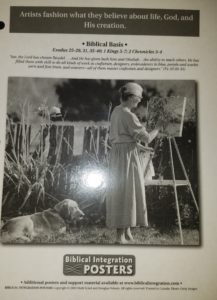How it all began.
The Practice of Faith-Learning Integration
 A frantic phone call. A quick visit at my door. A conversation at lunch. An emailed question.
A frantic phone call. A quick visit at my door. A conversation at lunch. An emailed question.
“I’m showing the periodic table today, what biblical principles should I teach?”
“Is there anything to say from a Christian perspective about The Giver which is on our reading list?”
“I want to give Scriptural reasons for computer keyboarding: any ideas?”
“Could we talk about this article I found about smoking for health class so my students will hear a discerning, believing perspective?”
 That’s how it started. Christian teachers—conscious of their responsibility to communicate biblical truth in all things—collaborating with each other about biblical foundations. Spending over twenty years in the classroom alongside Christian school teachers helped to shape my continual passion for biblical integration.
That’s how it started. Christian teachers—conscious of their responsibility to communicate biblical truth in all things—collaborating with each other about biblical foundations. Spending over twenty years in the classroom alongside Christian school teachers helped to shape my continual passion for biblical integration.
Now 20 subjects are digitally available through my partner Curriculum Trak (see the faith-learning integration page here). There are 80 strands of ideas (4 per subject) of about 100,000 words. Each strand has a Christian philosophy, biblical foundations, attitude adjustment, and classroom ideas for immediate use. Here is an example from Fine Arts:
(Philosophy) Artists fashion what they believe about life, God, and His creation (Ex 25-28, 31, 35-40; 1 Kings 5-7; 2 Chr 3-4).
(Foundations) The works of an artist reveal his inner thoughts, feelings, and ideas (Prov 4:23; Matt 12:33-35).
(Attitudes) The value of artistic work is found in both its aesthetic merit and its accurate depiction of truth/reality.
(Ideas) Investigate the personal lives of different artists to identify how their life experiences and worldview are reflected to specific works they produced. Conversely, speculate on the beliefs of an artist based on his artwork and then investigate his personal life to see if your speculations were correct.
 Talking with teachers day in and day out about the subjects they taught made me focus attention on how natural and supernatural revelation should be interwoven. Creating everything from class philosophy to lesson plan development was crucial.
Talking with teachers day in and day out about the subjects they taught made me focus attention on how natural and supernatural revelation should be interwoven. Creating everything from class philosophy to lesson plan development was crucial.
 The pictures you see here are some of the original biblical integration posters. My wife Robin and other Christian school compatriots still have these displayed in their classrooms. Biblical truth is literally in front of their classes.
The pictures you see here are some of the original biblical integration posters. My wife Robin and other Christian school compatriots still have these displayed in their classrooms. Biblical truth is literally in front of their classes.
Now teachers have so many more resources at their disposal! Here are the 20 subjects available for K-12 Christian schools and their teachers:
* Fine Arts * Government * Health / PE * History * Language Arts * Literature * Math * Science * Technology * World Languages * Bible * Celebration * Communication * Media * Money * People * Places * Things * Vocation * Writing
 All those conversations, discussions, phone calls, and emails resulted in putting the cookies on the bottom shelf—showing teachers how the truths of Scripture form the framework for everything in God’s world. In turn, those Christian educators now influence the thinking of students in the classroom.
All those conversations, discussions, phone calls, and emails resulted in putting the cookies on the bottom shelf—showing teachers how the truths of Scripture form the framework for everything in God’s world. In turn, those Christian educators now influence the thinking of students in the classroom.
Training the next generation to ask, “How should I look at this subject from God’s point of view?” is the end result of what faith-learning integration can accomplish in the Christian school classroom.
 Dr. Mark Eckel has spent over 20 years teaching junior through senior high students and still teaches a 12th grade class each week. Mark is President of The Comenius Institute (website), spends time with Christian young people in public university (1 minute video), hosts a weekly radio program with diverse groups of guests (1 minute video), interprets culture from a Christian vantage point (1 minute video), and his video teaching on Old Testament Overview, Wisdom, and Suffering is also available (video).
Dr. Mark Eckel has spent over 20 years teaching junior through senior high students and still teaches a 12th grade class each week. Mark is President of The Comenius Institute (website), spends time with Christian young people in public university (1 minute video), hosts a weekly radio program with diverse groups of guests (1 minute video), interprets culture from a Christian vantage point (1 minute video), and his video teaching on Old Testament Overview, Wisdom, and Suffering is also available (video).

